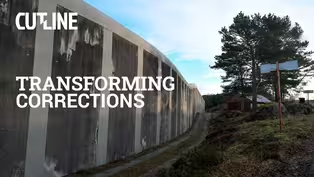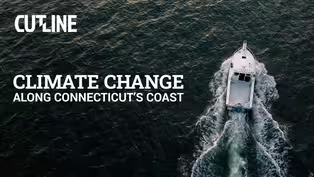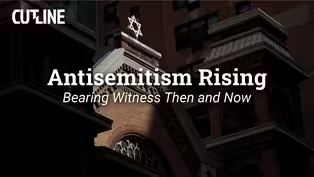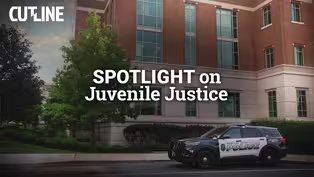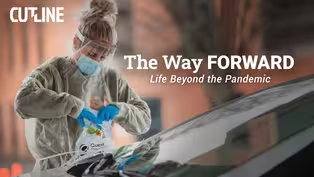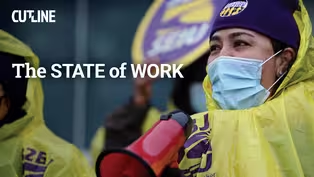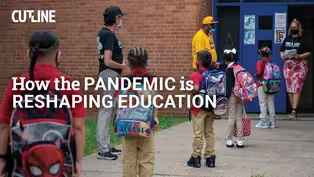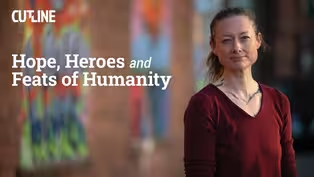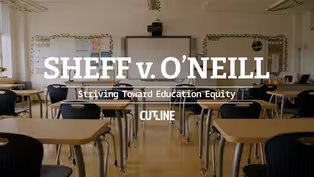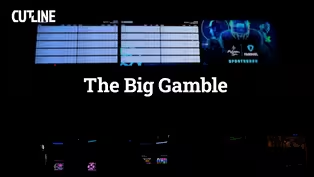CUTLINE
Health Equity in the Wake of Covid
Special | 56m 49sVideo has Closed Captions
CUTLINE: Health Equity in the Wake of Covid will explore what true health equity means.
CUTLINE's Health Equity in the Wake of Covid: How a Pandemic Highlighted a Legacy of Inequity in Our State will explore what true health equity means, the history of a lack of access to care itself, the work that hospitals and community health centers are doing to engage hard-to-reach communities, and how a pandemic brought into focus the disparate health outcomes that are prevalent in our state.
Problems playing video? | Closed Captioning Feedback
Problems playing video? | Closed Captioning Feedback
CUTLINE is a local public television program presented by CPTV
CUTLINE
Health Equity in the Wake of Covid
Special | 56m 49sVideo has Closed Captions
CUTLINE's Health Equity in the Wake of Covid: How a Pandemic Highlighted a Legacy of Inequity in Our State will explore what true health equity means, the history of a lack of access to care itself, the work that hospitals and community health centers are doing to engage hard-to-reach communities, and how a pandemic brought into focus the disparate health outcomes that are prevalent in our state.
Problems playing video? | Closed Captioning Feedback
How to Watch CUTLINE
CUTLINE is available to stream on pbs.org and the free PBS App, available on iPhone, Apple TV, Android TV, Android smartphones, Amazon Fire TV, Amazon Fire Tablet, Roku, Samsung Smart TV, and Vizio.
More from This Collection
Connecticut Public’s monthly deep dive into current issues, ideas and events that are most on our minds in Connecticut.
Video has Closed Captions
Explore how leaders and policy makers are trying to transform corrections in Connecticut. (47m 25s)
Climate Change Along Connecticut’s Coast
Video has Closed Captions
Learn about Long Island Sound’s importance and how its communities need to be protected. (51m 10s)
Video has Closed Captions
A look at the decade after Sandy Hook, and what has changed since the mass shooting. (53m 26s)
Antisemitism Rising: Bearing Witness Then and Now
Video has Closed Captions
Hear personal stories of the Holocaust and look at links between antisemitism & extremism. (57m 14s)
Video has Closed Captions
The Accountability Project takes a deep dive into Connecticut’s juvenile justice system. (56m 49s)
Video has Closed Captions
Learn how COVID and a collapsing childcare industry are impacting kids’ wellness. (57m 50s)
The Way Forward: Life Beyond the Pandemic
Video has Closed Captions
A look at the people and organizations helping shape life beyond the Pandemic. (57m 28s)
Video has Closed Captions
An exploration of the ways work has-- and has not-- changed as a result of the pandemic. (56m 17s)
How the Pandemic is Reshaping Education
Video has Closed Captions
We explore how the COVID-19 pandemic has reshaped education. (56m 40s)
Hope, Heroes and Feats of Humanity
Video has Closed Captions
Meet people from CT who’ve done audacious things over the course of a difficult year. (54m 28s)
Sheff v. O'Neill: Striving Toward Education Equity
Video has Closed Captions
Sheff v. O’Neill has created a model for school integration programs, and controversy. (55m 54s)
Video has Closed Captions
Connecticut has legalized sports betting. Where does the money go? What about the tribes? (53m 36s)
Providing Support for PBS.org
Learn Moreabout PBS online sponsorship[Announcer] Funding provided by Access Health CT. - (cool soft music) - The Coronavirus pandemic has highlighted a fundamental fact.
Disparities in health outcomes by race and ethnicity, exist across the country and the state.
And COVID-19 has taken an unequal toll on Black people, Latinos and Native Americans.
Nationwide Black people have died, at nearly two times the rate of white people, and in Connecticut, Black people make up, just 10% of the population and 14% of COVID deaths, according to covidtracking.com.
The economic impact of COVID-19 on communities of color, has been equally staggering.
In this episode of Cutline, we look at COVID in Connecticut, through the lens of race and equity.
We'll talk with stakeholders and care providers, and we'll examine the structural issues, that force people of color to bear a disproportionate burden of the virus' wrath.
I'm Khalilah Brown-Dean, this is Cutline.
(soft calming music) The loss of Morgan Cobbs, Jr and Evelyn Cobbs, are just a few of the nearly 600,000 COVID related deaths, in this country, more than 8,000 here in Connecticut.
- Both my dad and my grandmother, were sort of slowing down just a bit, leading up to them going to the hospital.
My dad had had a cough, and something that he had been battling for some time.
It sort of went away, but then not really.
And this was taking place in March, at the time when things were just closing down, things were quite scary.
We were all asked to be on lockdown.
And we were kind of pleading with him a little bit, "Daddy, we think you should go and get a COVID test."
also at a time when COVID tests, were sort of not that simple to come by, the way they are today.
Yes, he was able to go to a drive-thru and get a COVID test, but results were not immediate.
They would have been like five to seven days, for a result to find out.
And it turned out with him, we didn't really have five to seven days.
What ended up happening was that cough, was really getting the better of him.
I could hear it.
My sister could hear it.
And we decided, "Why don't we just call paramedics for you, and get you checked out."
I remember when the paramedics came that day, it was a chilly cold March rainy day.
And for all that we had been seeing on the news, it was just so striking to see EMS teams, really just literally put on all of their PPE gear outside in the rain before they would even come, and put their hands on my dad.
And they took him and we thought, at least he's in a good place.
We certainly couldn't join him due to protocols, around pedestrians going into the hospital.
But what happened was my grandmother, who he also cared for, began to show signs of weakness just a day later.
and someone who was a really good eater, she didn't want to eat.
So I had been calling her physician throughout the day, and in the end what I was seeing and unbeknownst to me, but what was exhibiting itself, was symptoms of COVID for her.
And so literally if my dad went on Friday, we were calling the paramedics yet again, for my grandmother on Saturday.
- I do recognize that we didn't know a lot about COVID, at the end of March.
We didn't know what we know today, I'll say it that way.
But there are inequities that showed up pretty quickly.
So an example was when my dad, when we convinced him to get a COVID test, I gave him the number to call, and he called me back shortly after and said it was denied.
And I said, "Well, Daddy, what did you tell them?"
And I said, "You have to tell them, that you've received a kidney, that you're a kidney transplant recipient."
I said, "Tell them that."
and I gave him some other things to say, that I wish I didn't have to tell him to say on his behalf, in order to get the test.
And the test was still denied a second time.
And so I'm now scrambling thinking who can I call, within the health system to get my father a COVID test?
And about an hour or two later, he called back and said, someone had reviewed his medical record in Epic, and they were going to offer him a test, because he was considered at risk or compromised.
But over that two day period of the worry, the back and forth, you know, trying to get him a test, I was there to advocate for him, but I think often of how many people didn't have a daughter, who works for the hospital where their father, is trying to get their tests from.
- Dana Cobbs, Darcey Cobbs-Lomax, thank you so much.
To give context around these inequities, in the healthcare system, I'm joined by Dr. Tekisha Everett, Executive Director of Health Equity Solutions, and Darcey Cobbs- Lomax is still with us.
She's Director of Community Connections and Social Impact, for Yale New Haven Health System.
Tekisha, we've heard a lot about the notion of equity, over this last year, but what exactly we mean when we say health equity?
- Well, when we're talking about health equity, we're thinking about the fact that, at the origins of our country, not everyone was treated equally, or had equal access to health and health care.
When we look at that in the contemporary sense, we're now seeing the outcomes of poor health status, or worst, health status, people living in neighborhoods, that don't necessarily provide the community resources, or health resources that are necessary, to attain their best health.
So ultimately when we're talking about health equity, we're looking for everybody to have a fair, and just opportunity to have their best health, regardless of any social factors.
So without regard to race, ethnicity, geography, income, education, et cetera.
- Darcey, how do these health inequities show up, when we're talking about both access to healthcare, but also the quality of that care?
Where are those disparities and who's most impacted?
- So that's a great question.
At Yale New Haven Health, and I would venture to say many health systems, across the state in the country, we follow the same definition that Tekisha gave, of everyone having a fair and just opportunity, to be as healthy as possible, is how we're defining health equity.
And as she mentioned, it requires us to be intentional, about naming racism and poverty, and other social constructs as undercurrents, that produce inequities in our community.
So within health systems, whether it's in the hospital or an ambulatory care site, we see health inequities show up in a variety of ways, including high readmission rates, longer length of stay, poor health outcomes, or disparities, if you will, between one population and another.
And health systems have struggled with this for many years, with how to manage these inequities.
They show up in quality, they show up in the responses that we get from our patients.
So there's a lot of initiatives that are happening, within Yale New Haven Health System, and across the United States.
But this is not a new challenge for us, but certainly COVID has, if you will, ripped the bandaid off and exposed it more broadly outside of our health systems, and health care centers to the broader community.
- Tekisha, let's talk about that, because Darcey said this is not new, to people who work in the field, or to people who experience these kinds of challenges, but for most people, it took this global pandemic, to bring this type of attention.
What is it that we have learned over this last year, and what should we be doing differently?
- Well, I like to think of it like this.
There are many of us who knew before the pandemic, the vast inequality and inequity that existed in health.
But if we didn't know before, we definitely know now.
We've been forced into our homes and not only able to read, and see on television and through all of the data, and statistics that have been shared, the deep, disproportionate impact COVID-19 has had, on communities of color and people of color.
But paired with that, we've been seeing the news, about the police brutality and the community brutality, against people simply because of their race and ethnicity.
I would dare say, what we've learned is that, we can no longer ignore the deep inequities, that exist in our country, that we are called to do something about it.
And what I'm hopeful for is that, we're going to move into action on these things, which I think we're starting to see, when you're looking at people who are examining deeper now, that asking the question, "Why did the pandemic, hit communities of color and people of color, in such a disproportionate way?
And what are we gonna do systemically to attend to that?"
Those are the questions I think, that we are dealing with now as a society.
- Darcey, there are lots of questions, that we're contending with.
There are interventions that are happening.
What are you seeing in terms of where we go from here, and those positive kinds of steps that we can take, to address health inequities?
- Sure.
So, Tekisha is aware of this fact, and you may be as well that we're often told in healthcare, that it's only 20% of what happens in the doctor's office, that affects your health outcome.
That it's really 80% of what happens, outside of the hospital walls or the providers walls, that that will affect your health outcome.
So internally, when you're at a doctor's appointment, you know, the doctor is there to provide care.
However, if the patient that's in front of you, has limited English proficiency, if there's not the appropriate interpreter services, available for a patient, and that includes sign language, if the patient doesn't feel comfortable or confident, oftentimes patients leave, and don't have all the information that they actually need.
So they get home and they deal with, all of the social determinants of health, that we hear talked about widely now, such as issues of food insecurity, housing concerns.
If you have asthma and you live in a place, that has environmental hazards or concerns.
So there's lots and lots of other things, that happen outside of the hospital walls, in the community that affects someone's health outcome.
If you don't have transportation to get, to your next medical medical appointment or follow up, that can also be problematic.
Internally, what we're seeing within our health system, and I think others across the country, is a real focused effort on equity, beginning first, internally.
So equity with our own employees, who are also our community members, who are also our patients.
What do our policies say and how fair and equitable are they for the frontline worker to our CEO?
And we're also spending a really focused amount of time, on our collection of race, ethnicity, and language data, which has not always been a focus for us, within the health system but it is today, and that's really, really important for measuring outcomes, for measuring disparities.
Outside of the health system, it takes a whole community to improve health outcomes.
And I've lived in four different states, and Connecticut is the first state, that doesn't have County government systems.
And that's, I think, I think it makes it difficult sometimes, to work on initiatives when your health department, covers one city or one town or a smaller health district.
So I think that is a bit of a limiting factor, for us here in Connecticut.
- There's definitely more work to be done.
Darcey Cobbs-Lomax, Dr. Tekisha Everett, thank you for joining us.
Black and Latino residents are less likely, to have health insurance compared to the total population.
Employment and income often determine whether people have access to health insurance.
But for undocumented immigrants, citizenship status creates additional barriers, to accessing preventative healthcare.
Connecticut Public Radio's, Brenda Leon, reports on what it's like to battle cancer, while undocumented during a pandemic, and the role that community health centers fill, for under-insured communities.
- [Brenda] Patricia Rosas has survived, both the Coronavirus and cancer, but now she worries about paying for a screening, to confirm her remaining kidney is cancer-free.
- [Brenda] Rosas is from Mexico and she's 52.
She's among the 120,000 undocumented people in Connecticut, who aren't eligible for state health insurance, for people with low incomes.
That's because they need to have citizenship status, in order to qualify.
About 6% of the state's population is uninsured.
According to a study by Access Health Connecticut, Black and Latino people accounted for 19%, of the uninsured population in 2018.
But that's only counting people who are citizens.
Meanwhile, 52% of undocumented residents, are without health insurance.
That's according to the Migration Policy Institute.
Rosas says she suffered in pain and silence for years, fearful that should be turned away from proper care, due to her immigration status.
- [Brenda] Rosas was sent home.
That was in the Spring of 2019.
With a stone in her gallbladder, Rosas says she delayed her visits to the emergency room.
Finally in the Summer of 2019, Rosas was able to be screened at a low-income community health clinic, even though she didn't have health insurance, She then got a referral to a specialist, but as the pain got worse, she didn't make an appointment, still afraid, she wouldn't be able to afford it.
- [Brenda] Across the state community health centers, provide a primary medical dental and behavioral health care, regardless of a person's ability to pay.
In Hartford, the Hispanic Health Council serves families under a model that bridges access to clinical services, preventative health education, and family wellness.
The organization was founded in 1978, after the tragic death of a baby girl, who's Spanish speaking mother couldn't understand the medical instructions she was being given in English.
This tragic death moved leaders to push for advocacy in health equity.
Yesenia Conde leads the Council Youth Services Department.
On average, the council serves over 200 families a year.
With the Coronavirus, that number nearly doubled.
Conde says it was eyeopening.
- The pandemic allowed us, to not just serve the families in house, but it allowed us to see that the need is even greater than what we thought, basic needs, mental health, social and emotional development in the children.
We serve a lot of immigrant families, Puerto Rican families, we serve Mexican families, really all Latino families.
We serve African-American families.
- [Brenda] Conde says about 20% of families get services, in more than one of the health council's departments.
- So that family will be receiving risk assessments.
They'll be receiving home visitation.
They'll be receiving referrals to other community agencies.
They'll be receiving one-to-one services.
And we do follow up.
When and if the parent, already received a service that they have requested, that they want, we always make sure that we follow up, every month, once a month.
And even when the case is closed out, we still keep them in our system for about six months, just to make sure that they're adjusting, and that they don't need to come back.
- [Brenda] The Hispanic Health Council, also trains their staff in cultural awareness, not only to understand the different cultures, of the community that they serve, but how their health intersects with other needs.
- Is it job placement?
Is it mental awareness?
Is it health equity?
So a lot of our families that are immigrants, unfortunately don't have health insurance, but their children do or a lot of families are scared, to go to the doctor's office, because they don't have health insurance, or because they feel like they're doing something wrong.
- [Brenda] Arelys Insignares works as a community health worker promoting family wellness, working directly to educate families, and connect them with services.
While the pandemic interrupted home visits, the center remained open, but more recently, Insignares resumed in-person visits, with mothers and their children, as part of their family resource center.
She works with mothers like Gladis Escalante who arrived from Guatemala 15 years ago.
Escalante has been working with Insignares since the birth of her first daughter 10 years ago.
Like many of the families, who visit the Hispanic Health Council, Escalante's family is of mixed citizenship status.
While Insignares is able to direct Escalante in the right direction to access health services, for her daughters, the help that Escalante can get herself is limited.
- [Brenda] So she works closely with Insignares, to educate herself and control her diabetes.
- [Brenda] During the pandemic Arely Ortiz-Perez, worked packing tomatoes, up into her last months of pregnancy.
She's also a participant in the family wellness group.
- [Brenda] Together, the women learn about key resources, while Insignares helps to facilitate workshops that become a key component of learning to prevent health crises.
(calming music) (calming music continues) - [Brenda] Rosas was admitted into surgery, in November of 2019, nearly seven months from her initial visit, to her local community health center.
Prior to her surgery, friends and family, started a go-fund-me to help her cover costs.
She was able to get financial help, from St. Francis hospital.
Her final bill of $57,000 would have left her, in crippling debt.
- [Brenda] In the past year, Rosas has participated in numerous rallies and shared her testimony.
(calming music continues) - Joining me now in studio, is Connecticut Public Reporter, Brenda Leon.
Brenda, talk to us about what you're seeing in the various communities with regard to health inequities.
- Well, Khalilah, I'm seeing a lot of things.
The first thing that comes to mind, is the access to the vaccine, right.
And we see that Latinos have the lowest vaccination rates, throughout the state, and there are a couple of reasons to that.
People have talked about hesitancy, but there's also the component of education, and really gaining the trust of the community, that they're trying to serve.
And so that comes in a couple of ways.
Really gaining trust with the community, specially in regards to serving them, in a way that's culturally understanding, of who they are and what needs they have.
But aside from that, there's also a lot of need, for more resources for things like nutrition, and things like a regular preventative healthcare services.
And so that also ties into the experiences of families, who might not be well acquainted with the American healthcare system, right.
And because the Latino community is very diverse, in and of itself, we're not talking about a monolithic group, right.
We're talking about people with many different experiences, and many different circumstances, economically with regards to citizenship, and also with regards to income.
And so that plays a role in how I'm seeing, how health equity plays a part, in the experiences of this community.
- There's so many layers and so many dynamics at play, that shape these health outcomes.
And one of the layers that you mentioned was nutrition, and access to food.
And you spoke with the woman who was running a food pantry, out of her home in Hartford.
Talk to us about that.
- Yes, Xiomy De la Cruz is a young mother, who came from Peru.
And because of her own needs, she started going to food pantries and collecting things.
She had a surplus of things, and she started a food pantry in her living room, because she saw that other mothers were also in need.
And so that became and it happens a lot, within the Latino community, I've been learning that, people find out and the information goes out word of mouth.
And so people are looking for essentials and not only food, but also diapers, milk, and Xiomy De la Cruz built her own pantry, and essentially that became a bigger project, and it was called "La Bodeguita de la Gente" in Hartford, and it was serving over 200 families in Hartford.
And so she was very aware, that the heart of the Latino community was in Frog Hollow.
And so they created a store, where not only they have the pantry, but also clothing and different items, that families might need on a day to day basis.
So these little things that we take for granted sometimes, are sometimes very much needed for families, who can't to have additional expenses throughout the week.
- One of the challenges that you've reported on, is for people who may have limited English proficiency.
They may have a difficult time accessing care, for themselves and for their family members.
Talk to us about that challenge.
So Milagros Vega needed support, with her grandson's schizophrenia, and she didn't have anywhere else to call, in a moment of crisis except to call the police.
And so there was a language barrier, right.
And so when I spoke to her, she expressed, you know, this is not only with the police department, when we are in need of a preventative, or a prevention rather in a moment of crisis, because I need to be able to communicate with someone, who understands my language.
And throughout that, it's not only with the police department, but also in the healthcare system as well, where families who might feel like, they won't be attended properly, because they don't know how to fluently speak the language.
And as I've learned throughout my reporting, people who tend to go and seek healthcare services, and go with someone who is an ally, and can speak the language there's a better outcome, than someone who goes, and tries to navigate the system by themselves.
- As you said, there's so many things, that we take for granted when it comes to health care access and the kinds of outcomes that we see.
Brenda, thank you so much for joining us.
- Thank you.
- People of color experience tremendous disparities, in health outcomes across a range of factors.
That's largely rooted in patterns of systemic racism, that shape health care delivery and other areas, like housing, education, economic opportunity, and environmental impact.
Joining us now to talk about access to care, and possible solutions are Kica Matos, Vice President of Initiatives, at the Vera Institute of Justice.
Dr. Setu Vora is Chief Medical Officer, for the Mashantucket Pequot Tribal Nation.
Steven Hernandez is Executive Director, at the Commission on Women, Children, Seniors, Equity, and Opportunity.
And Reverend Robyn Anderson, is pastor of the Blackwell Memorial AME Zion Church, and Executive Director, of the Ministerial Health Fellowship Advocacy Coalition.
Kica, the pandemic has highlighted a legacy, of health inequities that exist in our state.
Talk to us about what you've been seeing, and what's top of mind.
- Yeah, so I live in a neighborhood in New Haven, Connecticut called Fair Haven.
Fair Haven is a community whose population, is 83% people of color, and it is densely populated neighborhood.
It is where the majority, of undocumented immigrants live in New Haven.
And it is a place where a significant number, of essential workers live.
And when the pandemic hit, it really exposed the fault lines that we see in this state, when it comes to issues of race and access to healthcare, and issues of equity.
And so the bottom line when it came to the pandemic, is that we had one of the highest rates of infection, in the entire state.
And then when the vaccine began to be rolled out, we were one of the communities, that had least access to the vaccine.
Because we have a significant number, of undocumented immigrants, we also saw the lack of attention and access to solutions, around the pandemic and equity when it came, to some of the most disenfranchised people in this state.
- So what would more attention look like, but also the appropriate attention, to improve some of the challenges you just mentioned?
- Like I have said very bluntly, that the state has failed communities of color, in this state, in New Haven, in my community.
Why is that?
Because people of color are routinely marginalized, and left behind.
Despite the fact that the pandemic hit my community, and the infection rates were three or four times, that of other parts of the state, at no point in time, did the state focus attention on communities like mine, to say, "Okay, we have a significant problem here.
We have to identify the reasons why the pandemic, is affecting this community of color uniquely.
And we have to figure out what we can do."
So we were left on our own devices to try to figure out, how do we get access to the PPE, to give to communities of color?
How do we try to protect our communities, from this devastating illness?
How do we support people who have loved ones die, and they can't afford the kind of burial, that they want to get them?
When it came to the pandemic, what did we see?
We again, saw a real lack of attention, to issues related to culture.
So for example, a lot of the website, that provided pandemic information was in English only.
You could hit a button, to have a terrible Spanish translation.
A lot of the fact sheets were also in English.
Were looking at a population in my community, with lack of access to wifi, a lack of access to computers, significant language barrier And we realized in short order, that we were gonna be the ones, who were gonna have to find the solutions, to these problems ourselves.
And that's what we set about to do.
- So Dr. Vora, Kica mentioned, a number of those systemic challenges.
And I wondered if you could talk to us, about how poor access to care, and engagement in the communities that you care for, are playing out.
- Certainly, you know, I represent the health interests, of the Mashantucket Pequot Tribal Nation, as it's chief medical officer.
But I can speak certainly from my experience, from learning throughout Indian Country, that access to not just the care, but timely trusted information delivered by local champions, is oftentimes missing in native communities.
And what the pandemic has highlighted for us, is that sometimes just access is not enough.
It has to lead to acceptance by the people, that we all serve.
And I think the central missing piece perhaps, is the fact that trust is a vital determinant of health, and how maybe start rebuilding and in many cases, building trust, not during a crisis, but as one of my mentors in a mindfulness training told me, the best time to fix the holes in the parachute, are when we are safely on the ground, and not while we are actually jumping out of the airplane.
The same holds true for our collective work, with Native populations, Indigenous people, and certainly any other communities of color, underrepresented communities.
So I think we have a lot of work ahead of us.
We know that poor access leads to adverse outcomes.
Native communities have much higher incidence of COVID.
They have a higher risk of comorbid conditions, that results in more severe disease and death.
- Reverend Anderson, what about you?
How are you seeing poor access to care, and engagement in the communities you care for manifest?
- Thank you for that question.
In many different ways, the medical system, really has, in many ways, failed the Black and Brown community, in terms of not really having access to care, whether or not having insurance.
I've had several of my members of my congregation, who were working with minimum wage jobs, and were accessing insurance, because they did not meet the income level, for a free insurance through HUSKY.
And they were paying premiums, but had to make choices, of whether or not to eat, or to actually pay their insurance premium.
So there's many people that have had that kind of experience are people in the medical field don't look like them.
And so in many ways they don't feel like, they understand some of the concerns and some of the issues, that they have had.
I mean, we've been through this a hundred years ago, with the Spanish flu, the same thing.
The disproportionate amount of people, because of health disparities, because of the lack of access to healthcare, people of color died in disproportionate rate, just like we're seeing now.
And so the question becomes to me, what are we going to do, so that people feel like they have access to healthcare, and access that healthcare?
And also feel like our people do have a genuine concern, about their healthcare, and not just because we're in a pandemic, and all of a sudden we need you for herd immunity.
And so we want to make sure, we're concerned about the health care, but really making sure that things are in place, to address the disparities that Black and Brown people, face each and every day.
- Steven, Reverend Anderson laid out for us, a number of issues and challenges that seem nested, but they also seem nested across a number of groups.
What are you seeing in the work that you do, about how these issues show up?
- Dr. Brown-Dean, thank you so much, firstly, for having us and for that question.
The deleterious social determinants of health, the way that we've talked, about the social determinants of health for so long, in some ways avoids the vital point.
And the vital point really came to a head, in the state of Connecticut legislature, where Senate Bill one, in section one, declared racism a public health crisis, in the state of Connecticut.
And what's powerful about that, is that we have finally been able to utter as an institution that racism was by design deleterious, to the health of people of color, specifically Black people in the state of Connecticut, and in this country.
So when we think about what it is, that we see across the board, we don't only see these impacts, in African-American communities, but also in Latino communities, and other emerging communities in this state.
And why is that?
Because the very infrastructures that were created, to exclude some now exclude others as well.
And those outcomes that we're describing, whether they be health outcomes, educational outcomes, access outcomes, intergenerational cycles of poverty, those are all the results.
And because these systems were created to do what they did, they need to be re-imagined and recreated, to do something different.
And that is the work of policy.
That is the work of prioritizing budget.
That is the work of working with impacted communities, and hearing from their lived experience, the barriers that they face every single day.
I'll give you a couple of examples of what seeing, Doctor.
First of all, let me give you the example of two gentlemen.
These were two hypothetical gentlemen that were created, by a study done by Access Health Connecticut, our insurance exchange here in the state, on health inequities.
One gentlemen born in the city of Hartford, the other one born just down the way, about five miles in West Hartford.
Two very similar early experiences, they were each born into a family, but very different outcomes.
An average of 15 year difference in life expectancy, between the African-American gentleman, and the Caucasian gentleman down the street.
A quality of life that is severely diminished, for the African-American gentleman, even though he didn't have the benefit of living, as long as this counterpart five miles away.
What that says to me is that at stops along the way, the infrastructures of support, of prevention, of intervention at the right moment, of continuous assessment and improvement, when it comes to health we're just not there, for the gentleman in Hartford.
So the real question from a policy perspective, that we have to ask ourselves, isn't, how do we support the fact, that we need to do something different?
It's how do we actually do different to do better?
- I want to talk about the impact but also what is being done from the community level, to address many of those structural factors, that you just mentioned, Steven, but to also push back, against some of the challenge just that Kica mentioned.
And so Reverend Anderson, talk to us, about what you're seeing in the community, in terms of the impact, but also efforts to address some of them?
- One of the things that we have continued to see, in having the COVID-19 crisis council, who have worked all over the state is just to see people, one, that still did not have insurance, who really did not know where to get tested, did not really quite understand about COVID-19, and the urgency and the frequency of being tested.
And then to see also the amount of people that had COVID.
And also the whole entire family had COVID-19, and not knowing where to quarantine.
Did not have a place to quarantine.
Did not have the funds to be able to quarantine as well.
So one of the things that we have really done, is to really one, we made up wellness kits, made sure people had masks, and many people didn't have supplies, made sure they had sanitizer.
Made sure that they understood and knew about COVID-19.
How to store mask.
How to protect themselves.
The resources that were available to them.
If someone in the family received COVID-19, the contact tracing.
And then also even when the vaccines came out, really educating them about the vaccine, where they can get tested, answering some of the questions, and sometimes even bringing them to get tested, and also bringing them to actually get vaccinated.
And so we have continued to see the real despair, that has really place in so many lives, in the lives of Black and Brown people.
So the question becomes, even as we speak about this, and even as we talk about this now, what are we going to do to make sure, we don't go through this again?
That we're not back where we started from a 100 years ago, with maybe a different pandemic with a different name, but the same disparities, the same racism issues that we continue to see?
The same lack of access to healthcare?
That it would be a tragedy that after we move, through this pandemic, we still have the same issues going on, and not a plan to be able to address those.
- Kica, lets talk about that change that is happening, because as Reverend Anderson suggested, it's not about waiting for others to make those change.
It's really often about communities, organizing for themselves on behalf of their interests.
Talk to us about how communities of color, are mobilizing to address these inequities, both in access and quality of care, particularly in response to COVID?
- Sure.
So I would mention two distinct efforts, that are taking place in Connecticut right now.
At the state level, there have been significant organizing efforts, taking place to push a bill that would expand access, to the HUSKY Health Plan, for the undocumented community in Connecticut.
There's about 121,000 people who live in our state, who don't have documentation.
And 52% of these folks don't have healthcare, and this has compared to 6%, of the population in the entire state.
So activists are pushing to make sure, that a bill passes to expand eligibility, for this particularly vulnerable population.
When it comes to the pandemic, I wanna start off by quoting my friend and colleague, State Representative Robyn Porter who often says, that those who are closest to the problems, are those who are closest to the solution.
When we came to realize that around COVID, our community was being left behind, in terms of access to the vaccine, we decided that we were gonna roll up our sleeves, and get to work.
And so we launched what we call, the "Vaccinate/Vacúnate Fair Haven" campaign.
And what we did was that we took the get-out-to-vote model and we offered people vaccine appointments.
For those who are home bound, we offered to have healthcare professionals, administer vaccines in their home.
For people who needed rides, we offered them free taxi rides, to the vaccination site and back.
And we committed to knock on every single door, in our community.
And during the time period that we had this campaign active, nearly 5,000 people were vaccinated, as a result of these efforts.
And the local community health care clinic, talks about the impact of our efforts, to the extent that now 19,000 people have been vaccinated in their clinic.
- Dr. Vora, that fight for equity, and that fight for self-determination, has been a persistent factor for tribal nations, across this country, but particularly here in Connecticut.
How are tribal nations organizing, to demand health sovereignty, and also change some of the outcomes, that we've seen during this pandemic?
- It begins with just being counted, and recognized at the outset.
And as most of you and the viewers know, Native populations are not unfamiliar, with infectious disease and outbreaks.
If you recall with the Colombian exchange, by some estimates, 80 to 90% of Native American populations, at that time was decimated.
So I think that historical trauma, is still alive and present.
And ongoing contemporary trauma, systemic racism, that our august panel highlighted already, results in a deep mistrust, with the institutions and systems that exist, even when the encounters were non-healthcare related, for many folks.
So at Mashantucket Pequot Tribal Nation, we're fortunate that the tribal council, and our respective tribal elders have always placed health, as our number one objective.
And the model of health sovereignty, is always a work in progress.
And what we decided was to certainly build on that, and secure access to vaccines, through our partnership with local health districts, and the state.
The tribes were given two options; either work directly with Indian Health Service and the CDC or work with local health partners.
And we believe in local partnerships, and we had an ongoing engagement, with our local community partners, healthcare systems, the state and the tribe, and its enterprises, both in terms of testing and tracing.
And we took that model to the next level, when it came to vaccination.
And thanks to the leadership of the tribal elders, they set the tone and the example of being early adopters.
And because of that, we were able to launch vaccination, throughout Mashantucket Pequot Tribal Nation, with safety and speed and balancing equity with efficiency, so that not a single dose goes wasted, and more shots get delivered and not on the shelf.
So it truly has been a work in progress.
There are a lot of lessons learned.
And it comes down to the simple fact, that it starts with total empathy.
How may we collectively understand people, and their concerns?
How do we relay scientific information, in a very transparent, easy to understand manner?
And then finally, how do we create that network of teams, that really act synergistically?
We cannot do it alone.
And if nothing else has been shown by this pandemic, it truly takes a broad public private partnership, to deliver on the value proposition, for the people that we serve.
- Steven, it sounds like it's not enough, to just talk about access, but it's also important to talk about people having options, good quality options, to make those kinds of decisions for themselves, and for their communities.
What are the solution-based demands, that you are hearing from communities, about being able to have those quality options and choices?
- Well, thank you so much for asking that.
So much of the informed choice as we call it, comes from information, and earnestly shared true information.
And that is based and founded, on an information infrastructure that is already there, and trust that has been built.
And what we found in the beginning of this pandemic, and even as we tried to work our way, through those initial months, is that the reason that we couldn't find, communities of color is because of that lack of trust.
We had never built that critical part, of the infrastructure of emergency response, with our linguistically diverse communities, and with our Black and Brown communities more generally.
So part of what we were doing through our pandemic, is building it as we flew it.
I'll give you an example.
Some of our approaches were initially neutral.
They were based on age, or they were based on on more generalized ways, of reaching community.
That's not enough.
It is community that will guide you into the front door, so that you can have that direct impact.
And so when you talk about choice, when you talk about options, health options and informed choice, parents, families, communities need to know, what the full landscape of their choices are, in terms of addressing health and that has to be honest.
And where that landscape is lacking, where there may be an access desert, whether it be in medication, whether it be an information or prevention, we need to nourish those deserts back to life.
And that is a relationship that has to be ongoing, with the institutions that are here to serve the people, and have not historically.
- Dr. Vora, you said that one of the real strengths, of the tribal nations in terms of the response here, and action was that tribal leaders lead by example, in terms of embracing access to vaccines, but also promoting that as a solution.
Do you think we would have seen better outcomes, if tribal leadership and Tribal Nation, had been empowered to do that earlier in the process, of promoting vaccines?
- I believe so, and we see that, not just at Mashantucket Pequot Tribal Nation, but across Indian Country.
The Navajo Nation as you recall was one of the hardest hit.
And that's the largest nation by geography, and population as well.
It had significant mortality, but they've turned the tide, because they embraced leadership, and certainly lead by example, by participating in even phase three studies.
And if you recall, Native communities are mistrusting, because of real concerns, around experimentation, forced sterilization, all the trauma that this group certainly knows about.
So for the Native leadership, to then embrace participatory research, so that Native communities are represented, in the study population, so that the results are meaningful back to those people, that was a great leap forward.
And I believe that Indian Country has shown, that when the local leaders take charge and lead, when they embrace health sovereignty, and use science with common sense, the adoption is much better, as compared to externally imposed or forced method.
- Reverend Anderson, what about you?
Do you agree that empowering communities of color, to be able to lead some of that at the beginning, may have helped us see more people, getting vaccinated early on?
- I believe that we would have been a lot further along, had we done this at the beginning, had we brought faith leaders, had we brought community leaders, had we brought tribal nations together, and really discuss together, how are we going to do this?
How are we going to reach the community?
What are some of the things that you feel and you know, that have worked?
Because who knows our community better than we do?
Nobody.
It requires community people, trusted people who look like them, people that they know are not just for them, not just here for the them now, but have been there for them in the long haul, and when this is all over we'll still be there for them.
- Stephen, one of the most important resources necessary, to protecting communities and advancing is trust.
And it seems abundantly clear from this conversation, that that trust is broken if it ever existed.
And it's not just trust in community, or trust and government and leadership, but trust that people feel their issues are being raised.
How do we start to build or repair that trust?
- Well, oftentimes we look at outcomes, and we think that they are indicators, of an ongoing condition that is based in community, there's something wrong with community.
When we see sickness, when we see poverty, when we see lack of access, our inclination is to think, that something's wrong with the community.
While in fact, it is the failures, the failures of the resources of government, of local institutions to really hone in on those problems, to hone in on those outcomes that are based by much larger, and much deeper issues, to hone in on them with resources, as it is that failure that we really need to address.
And that is an element.
There's an element of trust building, that needs to go along with that.
How do you do that?
You do that by not over promising.
You do it by delivering on what you promise.
And you do it by being humble before the task.
Being humbled before community and engage in community, as others have said, every step of the way.
We don't need you to solve our problems.
In many ways, we need you to stop being the problem, that has exacerbated the conditions, that we face in our cities and in our towns, where Black and Brown people live.
The real fact is that engagement, trust-building, those are action verbs, and there are action verbs that need to be led, by people with power, by people with resources, for people who have been downtrodden, by those institutions, generation after generation.
- Steven has given us a really important framework, for thinking about what should happen next, so that we're not just addressing COVID-19 today, but also thinking about the lessons and action steps, to be taken moving forward.
Thank you all for joining us.
(soft calming music) - [Announcer] Funding provided by Access Health CT.

- News and Public Affairs

Top journalists deliver compelling original analysis of the hour's headlines.

- News and Public Affairs

FRONTLINE is investigative journalism that questions, explains and changes our world.












Support for PBS provided by:
CUTLINE is a local public television program presented by CPTV
